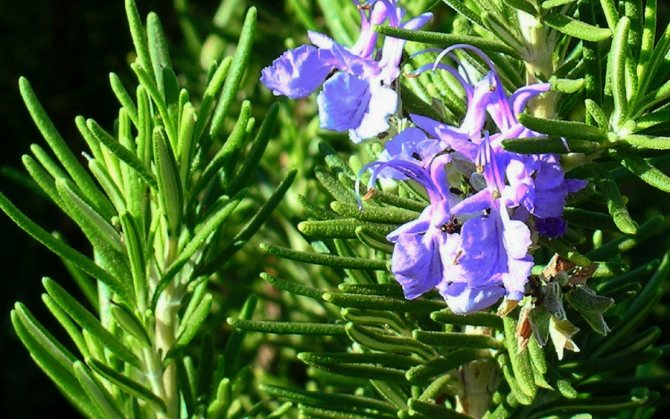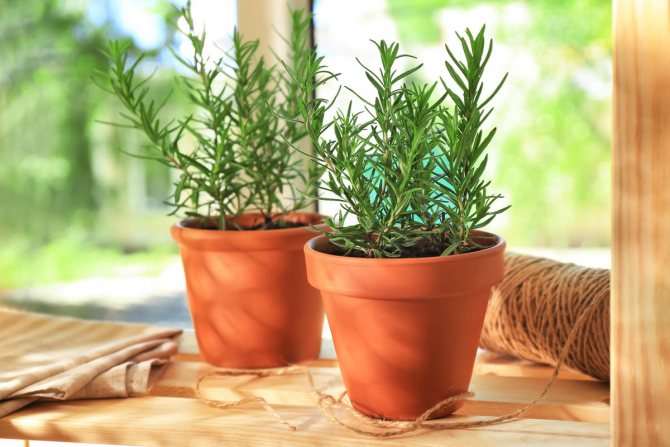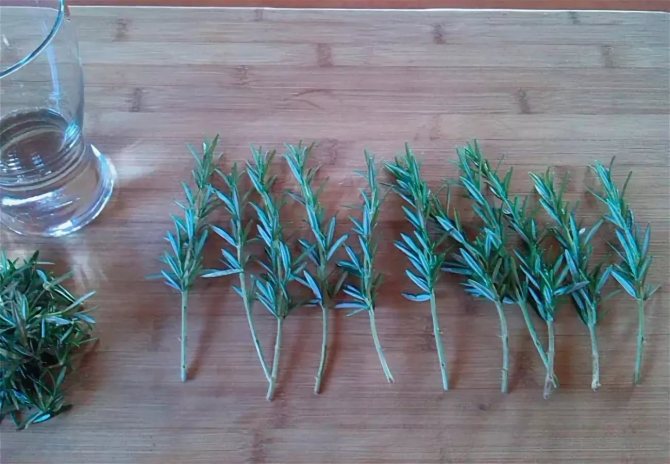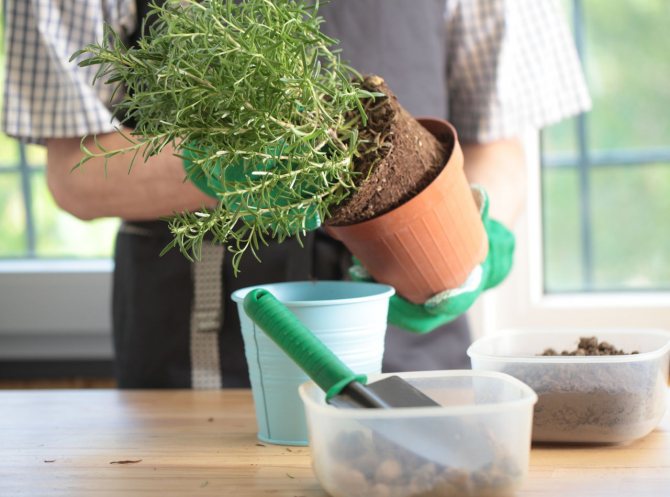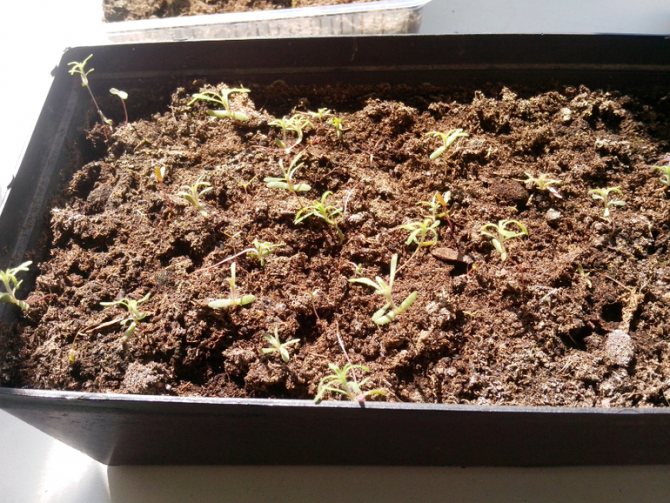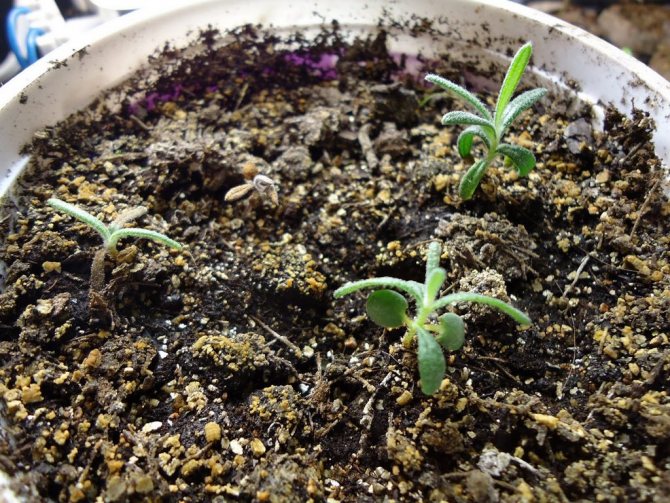Among spicy-aromatic plants, rosemary rightfully occupies one of the first places. In most European countries, it is grown everywhere, both in large agricultural firms and in private estates. And those who do not have their own piece of land cultivate rosemary as a houseplant so that they always have their favorite seasoning at hand. With us, it is just beginning to gain popularity, so many simply do not know how to grow this valuable crop from seeds at home. Meanwhile, this is not at all difficult to do, although you will have to be patient.
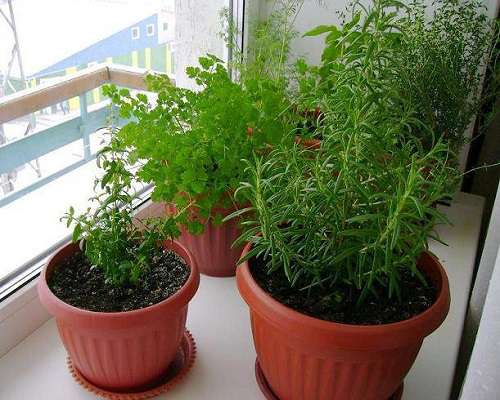
How to grow rosemary
Rosemary: propagation by cuttings at home, photo + video
My acquaintance with rosemary did not start very well. There was not enough experience and knowledge, the cuttings dried up as a result of non-compliance with the rules of planting and care. For some time she even refused to grow this most useful plant.
But, later, I returned to the idea of growing rosemary at home, since the essential oils that are part of the plant's tissues have a beneficial effect on the nervous system and are recommended to improve sleep patterns. I decided to prepare thoroughly, collected all the necessary information. I asked for cuttings from friends who have been growing rosemary for a long time. I succeeded, and now I am sharing with you how to propagate rosemary by cuttings at home.
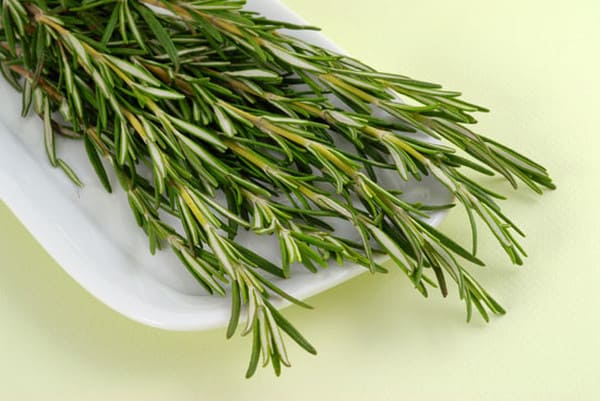

Benefits of rosemary
Rosemary
Rosemary is mentioned in biblical stories, and the ancient Romans believed that it has magical powers.
For decades, this plant has only been used for decorative purposes. Today rosemary is widely used. It is actively used by:
- in cooking as a seasoning for almost all dishes.
- in medicine, an infusion, an elixir of rosemary, is widely used, but the essential oil has become the most used, to which even Hippocrates attributed healing properties.
- in cosmetology it is an excellent remedy for face and hair care.
This beautiful and healthy plant pleases the eye and relieves headaches and fatigue with its aroma.
Brief description - what is rosemary
The plant is known as a medicinal plant, many use it as a spice and as a plant that contains essential oils and purifies the air. It is possible to grow on a garden plot only in the southern regions, since rosemary is quite capricious and demanding, it is a heat-loving plant.
In temperate regions, it is recommended to grow rosemary indoors. At the same time, you should avoid the main mistakes that many amateur flower growers make.
Origin
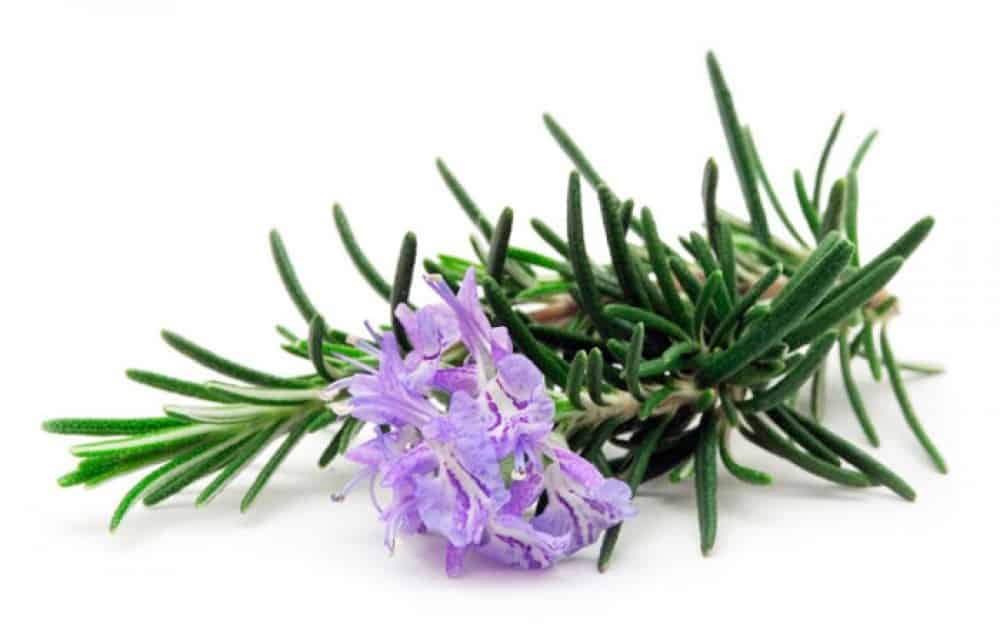

- Naturally, rosemary can be found in the Mediterranean, northern Africa and southern Europe. These regions are considered the birthplace of the plant. In Russia, rosemary does not grow under natural conditions, and since 1813 it has appeared in the Nikitsky Botanical Garden. As a cultivated plant, it can be grown only in the Crimea, where the climate is suitable.
- Rosemary has been known since ancient times. It was used as a medicinal plant and original spice by the ancient Romans, Egyptians and Greeks. Until now, the amazing "herringbone" has remained in demand and popular.
- Many grow cute bushes as ornamental plants with interesting needles and blue flowers.
Morphological signs
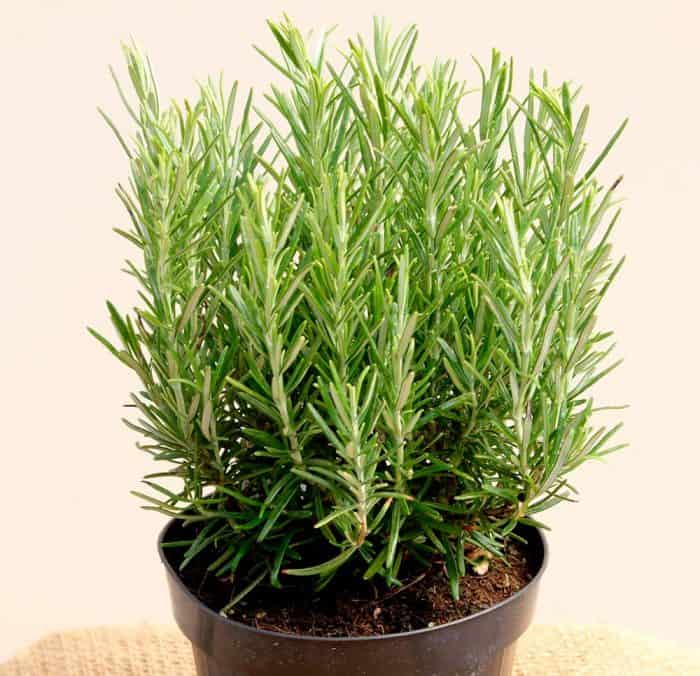

- Rosemary officinalis or ordinary is a subshrub or shrub. They attribute him to the Lamb family and the Rosemary genus.
- Bushes can be from half a meter to several meters high. The branches have a pubescent surface, their structure is four-sided.
- Leaves are linear, evergreen and are located on very small shoots. The upper part of the leaves is slightly rounded and compacted, may curl slightly.
- Flowering is expressed by almost sessile flowers, which form 5 - 10 false racemes. Formed on the tops of the branches. The corolla is pubescent on the outside, has a bluish-blue, with a purple tone, color.
- At the end of the flowering period, fruits are formed - oval, with rounded edges, a smooth surface, brownish-brown in color, the shape is nuts.
- The flowering period begins in the second half of April and lasts until mid-May. In hot countries, rosemary can bloom until November.
Technology of propagation of rosemary by cuttings
The main thing is to properly prepare for growing this herb, and then maintain and care for the plant. It will delight with fragrant twigs for many years later.
Choosing cuttings
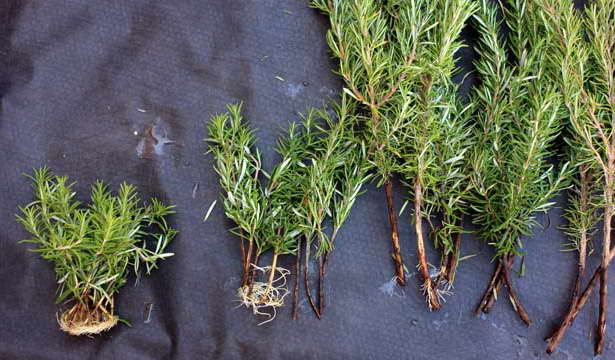

- You can go to a nursery or nursery and take sprouts about 10 - 12 cm long there. It is better to make blanks at the very beginning of spring. Autumn harvesting is carried out only in regions with a warm climate.
- Some people order cuttings online. There are many varieties of rosemary, there are white - green leaves, you can even find a bluish tint of the leaves. Bushes can be lush, but there are also those consisting of small and short shoots.
- If you plan to plant rosemary in the south, you can plant it all year round, except during winter. In areas with a temperate climate, cuttings should be prepared for planting from the third decade of April to early March. In this case, in late spring and early summer, you can plant grass in open ground at the site.
Important: cuttings are taken only from the upper parts of the shoots, these are the upper parts of the shoots taken from adult rosemary bushes.
Preparing cuttings
The most common mistake that growers make is that the cuttings are not kept for a long time to form root shoots. Planting directly into the ground contributes to the death of the shoots. They don't take root.
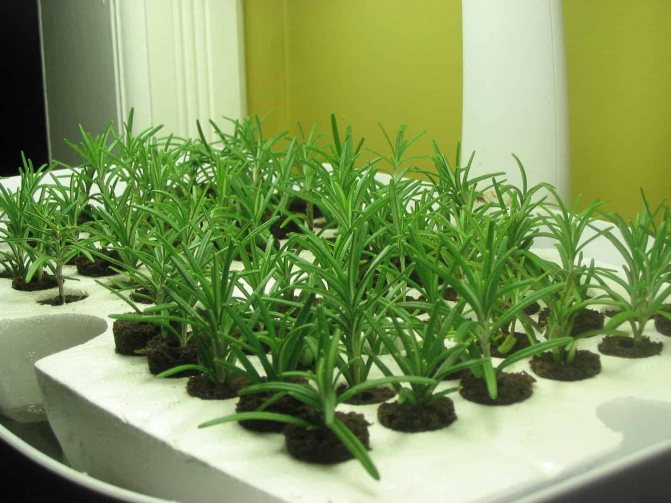

- Prepare a container in advance, you can use a container or a pot. Prepare the land also. Most often, a ready-made formula is purchased. But the option of self-preparation of the soil is possible.
- Take such components: humus, black soil, river sand and peat. Mix until smooth.
- The bottom leaves of the rosemary must be removed and the cuttings are planted in the prepared small holes. Deepen the sprouts 3 to 4 cm.
- The soil needs to be very well moistened, after planting, water the soil again. Next, place the pot or container on the windowsill and wait for rooting, which will take place in 4 to 6 weeks.
- It is very important to follow the watering rules. It is necessary to moisten the soil moderately, but often, at least 3-4 times a week. At the same time, the soil should not be poured, and excess water should be drained from the pallet immediately.
- After the specified time, the cuttings must be removed and transplanted into open soil. It is important that the soil warms up well. If there is no garden plot, then you can grow rosemary on a balcony or loggia. Night and day temperatures, their alternation, are positively perceived by plants.
There is another way to wait for the roots to appear in the cuttings. To constantly control root formation, you can place the shoots in cups of water. It must be changed at least once every 3 days. It is important for the sprouts that there is enough light and heat in the room.
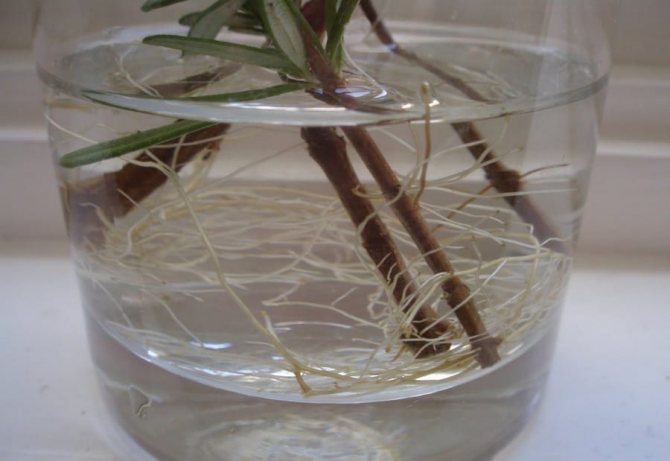

Since rosemary is a rather capricious and demanding plant, you should carefully consider the composition of the soil.It is strongly not recommended to grow rosemary in a soil that is heavy and dense, with a lot of clay and alkali. Be sure to loosen the soil so that moisture does not linger in the roots.
It is important to maintain balance and water very sparingly. Excessive moisture will cause the cuttings to rot. Too dry air and lack of moisture are also harmful to plants.
When to plant
- Depending on the climatic conditions, rosemary is planted at different times. In the middle lane, the optimum temperature for planting is within +5 - 10 degrees. In the northern regions in the open field, it is undesirable to grow this plant, since the low temperature and drops will not allow the root system or shoots to develop well. Plant only in greenhouses and hotbeds.
- In the central regions, a rosemary bush is planted from the second half of April. If the air temperature drops below -5, then the rosemary will die. Therefore, for autumn and winter, the plant should be dug up and transferred to a room in a warm place. In this way, the plant can be grown for many years.
- In the room where rosemary grows, the temperature should be about +5 - 15 degrees, then the bushes will develop and grow well.
A place
The plant is very thermophilic and sensitive. Therefore, the north side is not suitable for him, as well as places where there are drafts or winds. Damp terrain with accumulation of water is also not suitable.
The most comfortable will be the east or south of the site, or a room where there are no drafts, it is warm, and there is a sufficient amount of light. Rosemary tolerates sudden changes in temperature.
It's good if there is a building wall or thick bushes next to the place where it is planted, which will protect the rosemary.
For a plant, it is necessary that the soil be light, loose, breathable and drained. The root system needs a sufficient amount of oxygen. And the soil should pass moisture well. If the soil is very acidic, then lime it. Add a small amount of dolomite flour and lime.
Lay a drainage layer at the bottom of each planting hole. You can buy expanded clay or other similar soil "baking powder" in the store. The use of pebbles, crushed stone or pieces of broken brick is allowed.
Landing
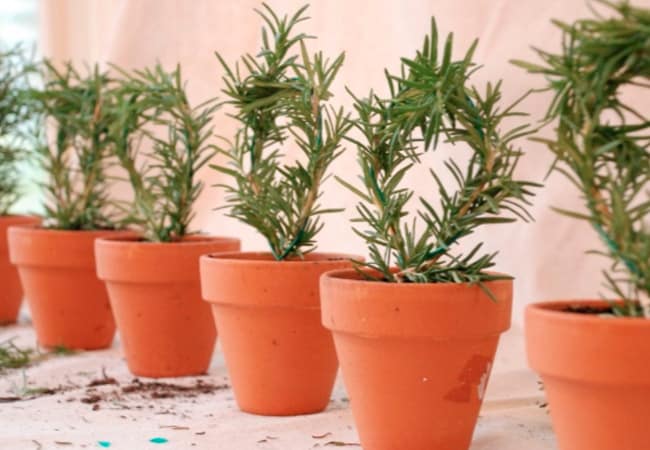

- Prepare a site in advance with the expectation that the distance between young plants should be at least 1 m.
- Prepare a special nutritious soil mixture for planting. Take in equal parts leafy soil, peat and river sand. Mix and add 1 tablespoon of finely crushed chalk to 1 kg of such soil.
- The cuttings are buried in the ground to the side leaves. Next, you need to water the plants and cover with plastic or plastic wrap. Only after 7 days can the shelter be removed. During this time, the cuttings should take root and take root.
Often, a plant that has been growing for many years has bare stems. Experienced growers are advised to remove all lateral shoots. This procedure is carried out no more than once every 7 years.
The first harvest is usually obtained 3 years after planting. The branches are cut along with the blue flowers. The branches are cut during the rosemary flowering period.
The shrub grows rather slowly, its maximum growth in a pot is about 90 cm. Each time it is transplanted into a more spacious container.
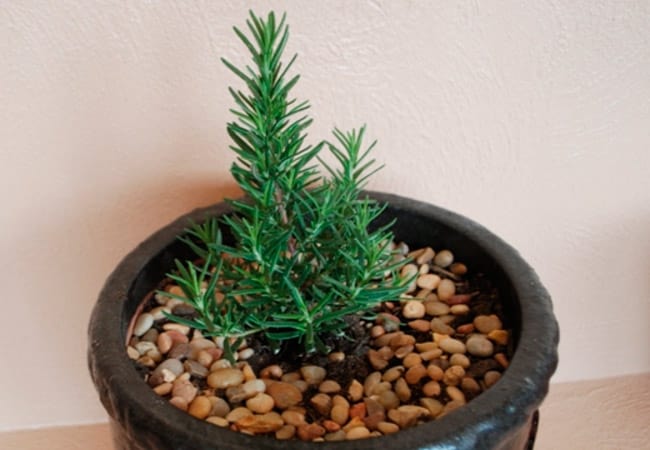

How to care for seedlings
And now the first sprouts appear above the ground. Seedling care does not require anything new except watering and maintaining a stable temperature. When 3-4 leaves are formed on the stems, you can prepare for transplanting into more spacious containers. To do this, we conduct an inspection, carefully so as not to damage the root, we thin out densely planted areas, transplant the plants into containers that are more suitable for growth and development. It must be remembered that the rosemary root grows rapidly, so the pots should be spacious, up to 10 cm in diameter.
When the plant reaches 8 cm, it is important to think about fertilization. To do this, you can take in the garden store "Ideal" or use another organic or mineral dressing. Upon completion, carefully loosen the ground around the plant. Fertilizer should be applied 5-7 times throughout the season.
Young rosemary
We will plant rosemary on the street when the danger of frost stops. But 2 weeks before that, you should start hardening the seedlings.
This is important for young plants, they must get used to the external environment.
To do this, we choose a suitable place and take the rosemary outside for the first time in the afternoon. In the early days, you should beware of direct sun rays and wind, which can harm young stems, on the seedlings.
The residence time needs to be increased every day. Over time, it is worth leaving the seedlings outside and overnight.
Expert opinion
Yulia Yurievna
I have a large garden and vegetable garden, several greenhouses. I love modern methods of plant cultivation and soil mulching, I share my experience.
Ask a Question
You can unpack the seedlings both in another box, and in separate glasses. The first method simplifies maintenance and saves space, but, in the second case, you can plant the plants in open ground using the transshipment method.
During the hardening period, at first it is worth placing containers with plants in a thin shade of trees or installing an awning using a special scattering mesh.
How can rosemary be propagated?
There are several ways to propagate rosemary:
- Cuttings. In an adult shrub, the tops of the shoots are cut off. Then they are rooted in a special substrate. Cuttings provide a number of conditions that promote root formation. Prepared seedlings are planted on the site.
- Seeds. With this method of propagation, it is important to prepare the planting material and soil. To increase the germination of seeds, they are treated. The seedlings are constantly looked after, they create a special microclimate in the room. When the bush grows up, it is planted outside.
- Twigs. The cut branch is kept in warm water. When the roots appear, the plant is planted in a pot or outside.
- By dividing the bush. The breeding method is used when transplanting rosemary. Its rhizome is divided into several parts, then planted in the right place.
- Layers. The rosemary branch is bent down and covered with earth. With intensive watering and feeding, roots appear at the shoot. Then the plant is transplanted to the site.
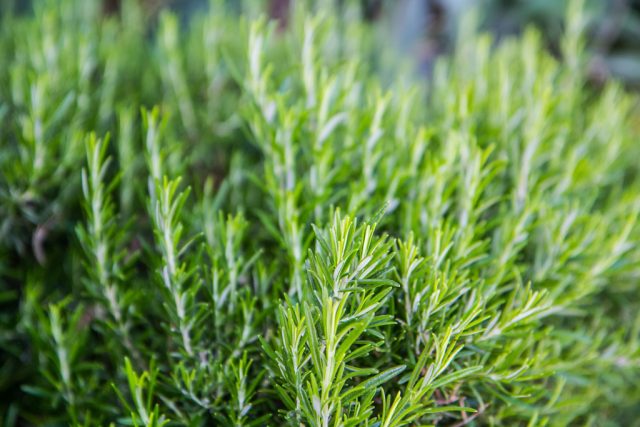

How to propagate rosemary by cuttings
A stalk is the top of a bush shoot. It is pruned from adult plants, bought in markets or in stores. For reproduction, a cutting 8 - 10 cm long with 3 - 4 internodes is sufficient.
The order of planting rosemary cuttings:
- Containers and soil are prepared for planting. The substrate is bought in a store or obtained by mixing black soil, humus, peat and sand.
- Expanded clay or broken brick is poured at the bottom of the container, then filled with soil.
- Depressions are made in the ground and cuttings are planted to a depth of 3 cm. All leaves are cut off at the bottom.
- The soil is well watered. The containers are kept in a warm, lighted place.
- When propagating a shrub, it is necessary to water the cuttings 4 times a week.
- After 1.5 months, the seedlings are transferred to a permanent place.
In the south, cuttings of rosemary are resorted to at any time of the year, with the exception of winter. In the middle lane, cuttings are prepared in September-October. In winter they are rooted, and in summer they are planted outside.
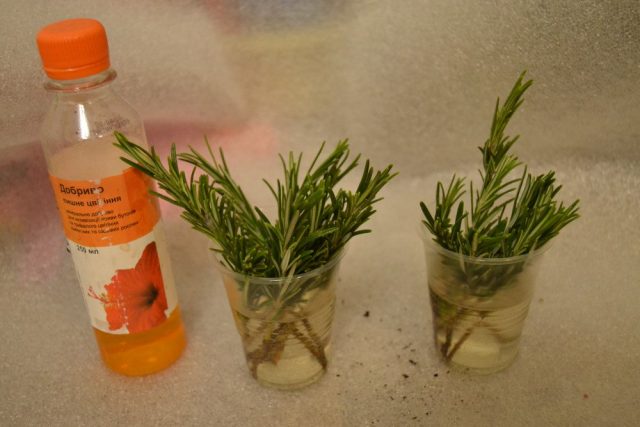

Cutting rosemary - the subtleties of harvesting cuttings and rooting methods
Very long branches are not needed for reproduction. Cuttings about 15 cm long are enough. If the stems purchased from the store are very tall, they can be cut into shanks.
At the bottom of the cuttings, where the roots will grow, you need to cut off all the leaves. The stem should be "bald" at a height of about 5 cm.
There are two ways to root rosemary cuttings:
- In water.The lower exposed part of the shank must be completely in the water. The plant grows roots for a long time, but after 14-16 days they can be seen. To prevent moisture from evaporating quickly from the glass, it must be covered with a cardboard. Make a cutout in it and insert the cuttings, fixing them. In the water itself, you can add an activated carbon tablet or a little Fitosporin solution.
- Immediately in the soil. It should be very loose. Under natural conditions, rosemary grows in soil with a neutral or slightly alkaline reaction. The soil for indoor rosemary must meet the same requirements. Do not forget about good drainage, because excess moisture for a plant is destructive. Until the cuttings are rooted, they should be kept under a hood.
If possible, it is better to use a stalk with a heel. It takes root faster.
When developed roots are formed on the cuttings, they can be transplanted to a permanent place. If this is a garden, then planting should be carried out not earlier than the end of May so that the bushes do not die from frost. In pots, rosemary will feel great in the room, but it is advisable to take it outside for the summer.
Video about the features of rosemary cuttings
How to dilute rosemary seeds
Planting rosemary seeds is best in late February or March. For reproduction, the seedling method is used. Planting is carried out at home, then the seedlings are transferred to the ground.
Before you start breeding rosemary, it is important to prepare the containers and substrate. For planting, choose pots no more than 15 cm high.A layer of expanded clay or other drainage is placed on the bottom. Openings must be provided in containers.
Soil for rosemary is prepared independently or you can buy a ready-made mixture. The best option is to mix garden soil with river sand and compost in a 2: 1: 1 ratio. Any soil with neutral acidity for indoor plants will also work.
Rosemary seeds are very small and take a long time to germinate. To improve germination, they are processed. First, the planting material is kept in water. When the seeds swell, start planting.
The order of reproduction of a plant by seeds:
- Containers with drainage and soil are watered abundantly.
- The seeds are spread over the ground. A layer of earth of no more than 0.5 mm is poured on top.
- Plantings are watered with warm water using a spray bottle.
- The container is covered with polyethylene and placed in a warm place.
Seedlings appear at temperatures from +25 o C. The film is regularly turned over and condensation is removed from it. To prevent the soil from drying out, every 2 - 3 days the soil is moistened with a spray bottle. The first shoots appear in a month. Then they remove the film and rearrange the containers to a lighted place. On average, when propagating rosemary seeds, seedlings wait 6 - 8 weeks.
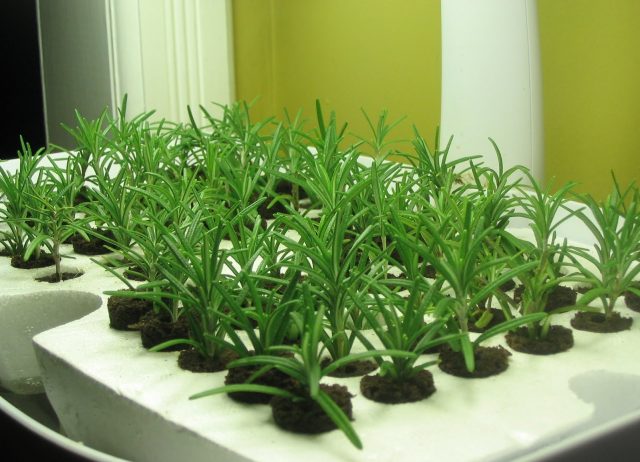

Planting rosemary seeds is not enough; it is important to provide the seedlings with good care. The containers are rearranged on the windowsill. The room temperature is maintained from +18 o C.
When the 2nd - 3rd leaf appears in the rosemary seedlings, they are dived in separate containers. Use soil of the same composition as when planting seeds. When transplanting, they try not to damage the root system.
When the seedlings reach 3 - 4 cm in height, they begin to harden it. First, they open the window and ventilate the room. Then the containers with seedlings are transferred to the balcony or loggia. Before planting in the ground, the plants must fully adapt to natural conditions.
Bushes 7 - 8 cm high are planted in a permanent place. For them, they choose a sunny place, protected from cold winds. The best soil for rosemary is light, fertile, and drained. Seedlings are transplanted into the ground in May-June, when frosts pass and warm weather sets in.
Sowing with seeds
Getting the seeds is not a problem. You can buy them at a gardening store.First of all, one must remember that seeds that have lain in a box for 3 years (subject to the conditions), significantly lose their properties to similarity.
The first rule is seed selection. You can take foreign seeds, they usually come already stimulated. They can be planted immediately. Or we can, domestic, which need to be soaked to increase the percentage of germination.
To be sure that the rosemary will sprout, as well as to speed up this process, we pre-prepare the seeds for sowing. For this you need:
- Pour with succinic acid solution or honey water (a teaspoon of honey in half a liter of water) for a day.
- In this case, empty, as well as unusable seeds will rise to the top.
- Drain the water, place the grains in a damp cloth. Keep it moist at all times.
Now we are waiting for pecking. This process can last about a month, so the end of February-beginning of March is the time to start preparing. Then you will have a better chance of harvesting this season.
Preparing the soil for the seeds is very important. The soil should be light, well-drained, with neutral acidity. To prepare you need to take:
- peat (1 part)
- river sand (1 part)
- turf (2 parts)
- sheet land (2 parts).
You can also buy ready-made soil at a gardening store.
Expert opinion
Yulia Yurievna
I have a large garden and vegetable garden, several greenhouses. I love modern methods of plant cultivation and soil mulching, I share my experience.
Ask a Question
During germination, the seeds must be regularly ventilated, otherwise mold may start there. We recommend opening them for a few minutes once a day. Moistening is best done with a spray bottle and only warm water.
There is a chance that the seeds will not hatch evenly. But, do not wait until they all germinate. If some are ready to plant, then you should start right away. Otherwise, the tip of the sprout may dry out, which will lead to the fact that such a seed will no longer germinate.
We recommend sterilizing the earth mixture three weeks before sowing the seeds. This can be done by roasting the soil in the oven. This procedure will destroy fungal spores and pests.
If you prepare the soil yourself, make sure it is not too heavy. To do this, you need to lightly moisten a few breasts and rub them between your fingers. The mixture should not feel like plasticine and should not stick too much.
If there is a similar sensation, add a little more peat to the prepared soil. It is best to always do this test, as even if the instructions are strictly followed, the mixture may not meet the requirement. As the quality of the ingredients may vary.
Rosemary grown from seeds
For sowing seeds, you need to take a spacious box with a depth of at least 15 cm (so the plants can be easily transferred outside in suitable weather) or special containers for seedlings. Before planting, the soil should be warmed up in a warm room.
Once the seeds have hatched, you can start the first stage of planting.
So the second rule is not to deepen. Not allowed:
- bury seeds deep in the ground;
- ram the ground;
- fill with water;
- create bumps over the planted seeds.
The deepening should not exceed 0.5 cm. Non-germinated seeds can also be planted, several pieces per cell. After the seeds are laid out, they must be sprayed with water, sprinkled with earth on top and sprayed again. But at the same time, the soil should only be moistened, and not become wet, since dry soil is considered ideal for growing rosemary.
Rosemary is best planted separately from other plants.
The third rule is a separate landing. For the very reason that rosemary takes about a month to sprout, you cannot plant it with other plants.
Others who have sprouted will no longer need a greenhouse. Rosemary is still needed.
The box must be covered with plastic or glass.At the same time, leave or make specially several holes to allow air to circulate in order to avoid the formation of condensation.
Rosemary is not picky about temperature, therefore, a stable one within 12-22˚C is suitable. At this stage, everything that depends on us is done.
Now we will wait for the shoots. But we must not forget, and periodically, in small quantities, spray our plants from a spray bottle.
The fourth rule is to wait. Of course, especially for those who undertook to grow for the first time, it is difficult to wait a month to see at least some signs of the life of future rosemary.
But these are its features. The main thing here is not to despair, not to get upset, not to throw away the pots.
Expert opinion
Yulia Yurievna
I have a large garden and vegetable garden, several greenhouses. I love modern methods of plant cultivation and soil mulching, I share my experience.
Ask a Question
When planting seeds, we recommend making shallow trenches along the box, and it is in them to spread the seeds at a distance of about 1-1.5 from one another. The same amount is worth retreating from the sides of the box.
Even if you make holes in the film, this is still not enough for proper ventilation. Therefore, once a day, you need to ventilate the seedlings in a warm room.
It's time to transplant rosemary outdoors. To choose a suitable place for any plant, you need to take into account the peculiarities of the climate and soil of its homeland. So for rosemary it is suitable:
- Sunny side (better planted from the south). With a lack of sun, rosemary will not have a strong, characteristic aroma, because under such conditions a small proportion of essential oil is formed in the plant.
- Dry soil (we choose a place on the slope, and lay out crushed stone on the bottom of the depression so that the water does not stagnate).
- Neutral acidity of the soil.
It is better to prepare the land for planting rosemary; ordinary soil in our area is not welcomed by this plant. To cook we take:
- leaf land (2 parts)
Cut rosemary - coarse sand (2 parts)
- peat (1 part)
- crushed chalk (at the rate of 25 grams per 1 kg of substrate).
The prepared mixture should be decomposed, we put drainage on the bottom and leave everything in this state for 3-4 days: we allow the soil to settle.
It is necessary to plant plants, taking into account the purpose of its cultivation. If we set a goal - to create a decorative planting, the distance between the bushes is allowed about 10 cm.But if it is planned to collect herbs from rosemary, the distance should be at least 50 cm.
Caring for rosemary in the garden is simple. All you need to do is weed and water sparingly.
Do not water during rains. A sign of a haughty amount of moisture can be a plant shedding leaves. If the leaves turn yellow, then the rosemary is not getting enough moisture.
While watching the video, you will learn about growing rosemary in a pot.
As you can see, growing rosemary at home is real and not difficult. You just need a little patience and love for plants. And they will surely answer you with a plant that enchants the eye, a scent that you can't breathe. If desired, using rosemary, you can prepare a lot of dishes and use it for other useful purposes.
Have you noticed a mistake? Select it and press Ctrl Enter to tell us.
Attention super FLY!
Medicinal plants
It is better to buy rosemary seeds for sowing in specialized stores. Before sowing, they are soaked in settled water for 2-3 days. Seeds are sown in shallow grooves 4-5 mm deep, sprinkled with soil and covered with a film. The planting is aired, and the soil is moistened with a spray bottle before shoots appear. When shoots appear, they are thinned out, leaving a distance between plants at least 30-40 cm.
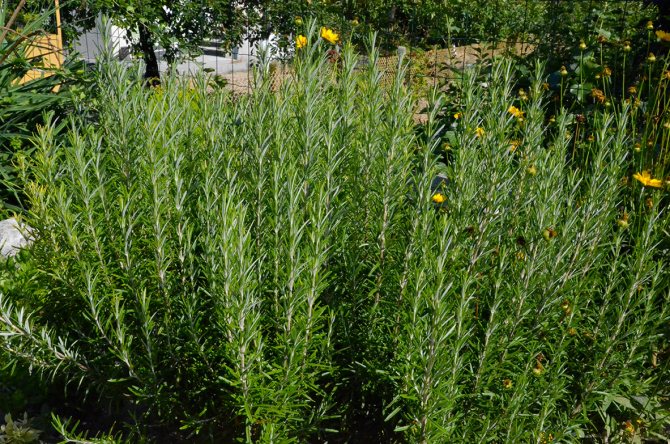

Rosemary in the garden
The optimal time for sowing a crop with seeds in open ground is late April-early May.
Advice. Before planting rosemary, the site is freed from weeds, the soil is carefully loosened, achieving a fine crumbly structure. This is necessary, since the seedlings of the crop are very strongly oppressed by weeds and poorly absorb nutrients and moisture from the soil, which has very large particles.
Let's take a look at how to grow rosemary seeds.
Planting seedlings
The process of obtaining rosemary seedlings from seeds consists of the following steps:
- For forcing seedlings, store special nutrient substrates or self-prepared soil mixture from low-lying peat (1 part), coarse sand (1 part) and garden soil (2 parts) are used;
- The seeds are pre-soaked for 5-6 hours, distributed over the surface of the substrate, and then sprinkled on top of them. The substrate is moistened from a spray bottle, after which the container is covered with a film and placed in a warm dark room;
Advice. Ensure effective drainage before planting rosemary seeds in prepared containers. To do this, a 12-15 cm layer of expanded clay or small pebbles is placed on the bottom of a box or container for distilling seedlings.
- To water and prevent the substrate from drying out, the box must be opened and the soil must be sprayed with warm water from a spray bottle;
- When shoots appear, the film is removed, and the box is placed on a well-lit southern windowsill. As the seedlings grow, they dive into separate pots;
- The seedlings obtained in this way are planted in open ground at a height of at least 7-8 cm.
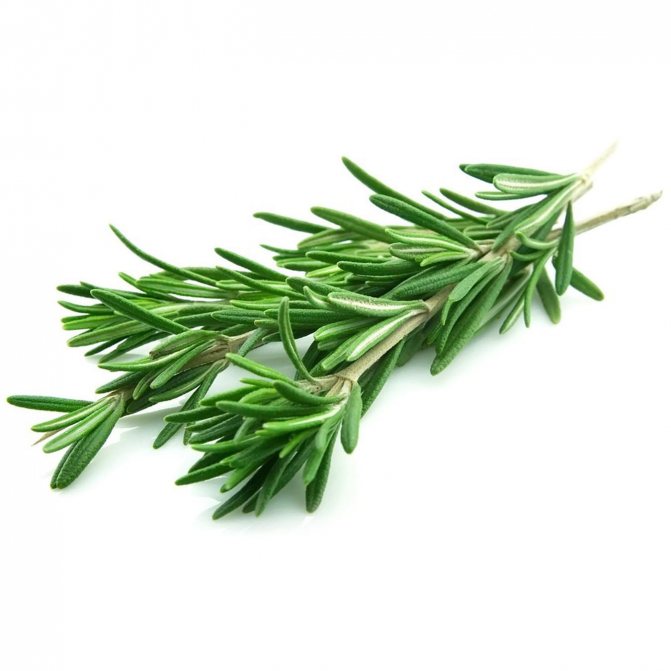

Rosemary sprig
When growing rosemary, both at home and in the open field, crop care consists of the following activities:
- Watering - during the growing season, plants are moderately watered, not allowing the surface layer to dry out, but at the same time not overmoistening it and avoiding stagnation of water in the zone of the root system. For irrigation, use rain water warmed up in the sun. When watering, they try to minimize the ingress of drops on the leaves. Watering is carried out in the late evening;
- Top dressing - If the rosemary grows as a houseplant, it does not need frequent top dressing. When grown in open ground, the culture is fed with special complex fertilizers 1-2 times a month. In winter, during the dormant period, feeding is practically not done;
- Loosening and weeding - as the soil is compacted and weed shoots appear, as well as after each watering, the soil is carefully loosened to a depth of no more than 10-12 cm;
- Pruning - pruning is done starting at 2 years of age. Shorten thickening bush, growing inward and diseased shoots. A simplified pruning scheme is often used, in which all shoots are shortened at the level of 3-4 internodes. This operation is performed in early spring (March-April);
Advice. To rejuvenate the old bush, every 6-7 years, all shoots are cut off at the soil level.
Advice. When growing rosemary in the middle zone (Moscow region, Non-Chernozem region, Ural) and Siberia, pots, containers with plants, as well as the resulting seedlings for the warm season are exposed or planted in a chosen place on the street, and in winter they are removed to cool rooms with a temperature of 10-13 0C.
Harvesting
How to grow rosemary from a twig
A large rosemary bush can be successfully grown from a twig. It is best to choose young shoots 5 cm long. They are cut from an adult bush. I use this breeding method at any time of the year. The twig is rooted at home.
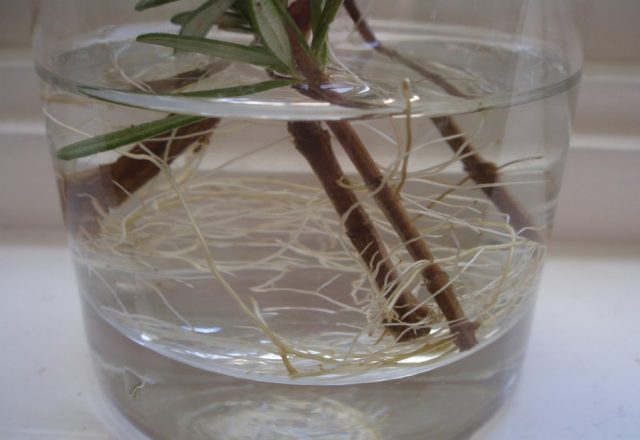

The order of reproduction of a shrub using a twig:
- The cut shoot is placed in a jar of water. A cornea stimulant can be added to the liquid.
- The water is changed every 3 days.
- When the branch has roots, it is placed in a container with light nutritious soil.
- Rosemary is watered in moderation, kept in a warm and lighted place.
When the seedlings grow up, they are planted on the site or left in a pot. You can root rosemary with branches in a greenhouse, where the desired microclimate is provided.
Rosemary or thyme: which to choose?
In order to grow thyme and rosemary, it is enough to have branches of these plants. These perennial crops look like small shrubs that propagate very easily by cuttings. For planting, you can buy greens in the store and select the freshest branches, then an oblique cut is made at the ends, and all the lower leaves are removed. The twig should be placed in warm water for 6 hours; for fast rooting, special preparations are used that are diluted in water, for example, Epin-Extra and others.
Before you can grow rosemary at home, you need to prepare the pots and scald them with boiling water. Expanded clay is placed at the bottom of each, and then fertile soil. The top layer is coarse sand, which is warmed up in advance. Water the soil with a weak solution of potassium permanganate. The prepared cuttings of thyme and rosemary are planted in pots and sprayed with water, and covered with jars on top. Also, do not forget about periodic ventilation. After three weeks, the sprouts will have roots, after which they can be planted in open ground.
Propagation of rosemary by dividing the bush
If rosemary is already growing on the site, it is propagated by dividing the rhizome. This method is used when transplanting a bush. Every year, a shrub over 5 years old needs rejuvenation. By transplanting, you can not only rejuvenate the plant, but also get new seedlings.
The need to transplant rosemary also arises when the shrub grows in the wrong place: it lacks moisture or sun. It is recommended to carry out this procedure in cases where the shrub is in the lowlands or suffers from excess moisture in the soil.
Work is carried out in spring or autumn, when sap flow slows down in plants. As a result, the shrub tolerates planting better and takes root faster in a new place.
Instructions for propagating rosemary by dividing the bush:
- The shrub is dug out of the ground or removed from the pot.
- The roots are cleared of the earth and divided into parts. Use a pruner or other instrument that has been previously disinfected.
- Each seedling should have several roots and shoots. If there are old, diseased or dried branches, they are removed.
- Places of cuts are treated with charcoal.
- The roots of the seedlings are immersed in water with the addition of a growth stimulant.
- It remains to plant the rosemary in containers or on the garden bed.
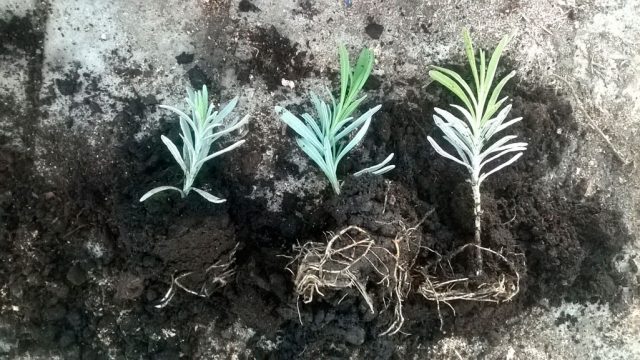

Basic rules for watering
When watering the sprouts, they should not be overmoistened. This will cause the roots to rot and the plants may die. It is important not to allow the topsoil to dry out completely. Once the soil is barely damp, water the sprouts again.
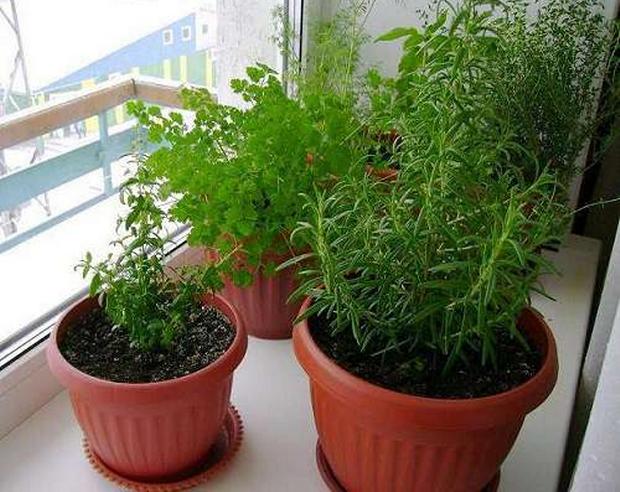

Growing on a windowsill
If the seeds are germinated correctly, then rosemary can not only provide the family with a tasty and healthy seasoning, but also become a decoration at home. To do this, it is enough to properly care for the plant.
How can rosemary be propagated by layering
It is convenient to propagate rosemary using layering. The procedure is performed in the spring. For this, choose 2 - 3 of the strongest shoots. Under them, furrows are dug with a depth of 5 cm. The branches are lowered down, fastened with metal brackets and covered with soil. Part of the cut must remain above the ground. Then the shoots are watered abundantly.
Mineral complexes are used for feeding. Mullein infusion and other natural remedies are used at the beginning of the season. An excess of organic matter inhibits the development of rosemary. Fertilizer is applied 2 - 3 times a month.
By autumn, the layers will take root well. They are separated from the mother bush and planted around the site.In cold climates, it is better to transplant the layers into pots for the winter, and move them outdoors in the spring.
"Bed" on the windowsill
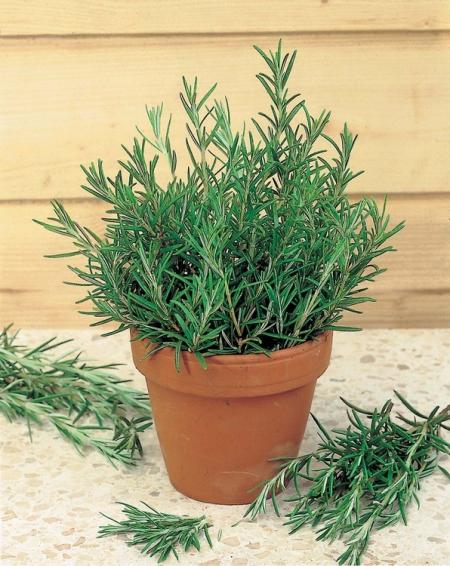

Rosemary can also be grown at home on a windowsill. It grows well in pots.
For the summer period, it will be best to take rosemary to the balcony, but do not forget, then, long before the onset of the first frost, bring it back into the room.
Otherwise, due to sudden changes in temperature, the leaves will begin to vigorously fall off. And rosemary can lose its decorative effect.
Gradually, over the years, the stems of rosemary become bare, so every year in the spring or mid-February, the crown must be trimmed.
An interesting fact is that the lower the temperature in winter, the better the rosemary then blooms in the spring. The most optimal temperature for it is 12 ... 14оС. Rosemary, grown at home on a windowsill, releases phytoncides that constantly disinfect the air in the room, while destroying viruses and pathogenic microbes, as well as successfully eliminating unpleasant odors.
Here is what a wonderful plant you can grow in your summer cottage, and at home on the windowsill. An exquisite spice, an excellent healer, and a spectacular garden decoration - all this is rosemary.
I suggest watching a very interesting video about this wonderful plant, which was shared with us by the reader of the site Evgenia. Thank you very much for that!
https://youtu.be/ATRukBObv_s
See you soon, dear readers!
Which way is better
The choice of breeding method for rosemary largely depends on the source data. The timing of the work is chosen taking into account the weather conditions in the region. If the shrub has not yet been grown, then it is better to purchase seeds or cuttings. If the plant is already on the site, then choose the propagation of rosemary by cuttings or layering.
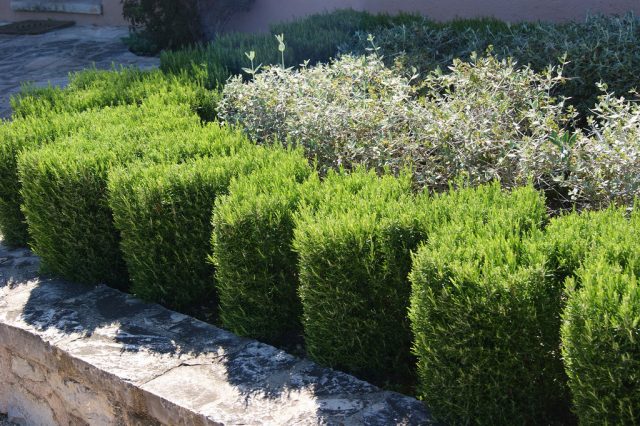

The most popular breeding method is cuttings. It is recommended to divide the bush during transplantation in order to less injure the plant. These are reliable methods in which all varietal characteristics are preserved. Reproduction using layering is more suitable for shrubs growing in the garden. At home, it is better to choose other methods.
Seed propagation is the most laborious method. To obtain healthy seedlings, it is important to use a good substrate, care for the seedlings and create a microclimate for them. When using seeds, the plant may lose varietal characteristics.
Growing from seeds
Another way to propagate rosemary is from seed. Seeds germinate for a long time, which must be taken into account when using this method of flower cultivation. They begin to germinate seeds no later than a month and a half before the onset of heat. To speed up the process, they can be pre-germinated in gauze soaked in water.
How to propagate an orchid at home
Procedure:
- Seeds are spread in prepared soil at a distance of 2 cm from each other and moistened.
- Sprinkle on top with a thin layer of soil and spray again with water.
- The container is placed in a warm place out of direct sunlight and with good ventilation.
Important! The soil should not be allowed to dry out, so it needs to be watered on time.
When the first shoots appear, you need to improve the lighting. Wait until the actual leaves appear before rooting the rosemary in separate containers.
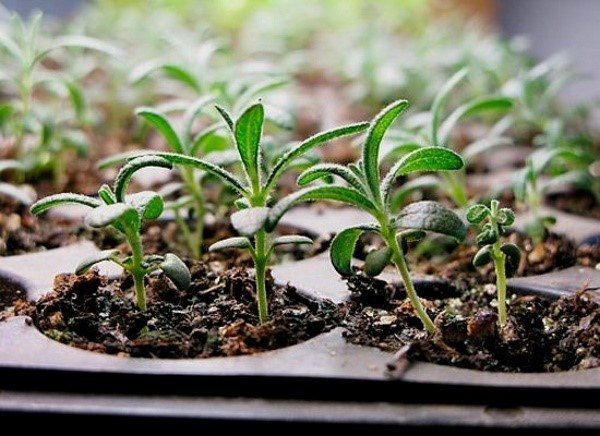

Growing a flower from seed
Features of growing rosemary from cuttings
One of the wonderful properties of the plant is the release of essential substances that can refresh the air in the room and rid it of pathogens. It will be a plus if you grow rosemary at home in pots and put them in children's rooms and bedrooms.
In the southern regions, shrubs can be propagated at any time, with the exception of the winter period. Gardeners in temperate territories at home are advised to select twigs and prepare seedlings in the spring (late March, early April), and in May, June, transplant them into the ground at the site.
Attention! Rosemary cuttings are the tops of the stems of the shrub. They must be cut from mature plants or purchased from specialized stores or the market. The main thing to remember is that only the upper shoots are taken.
Rosemary: outdoor cultivation
Planting rosemary in open ground is carried out in the second half of May, when the weather is stable. If you need to grow large bushes, then the seedlings are planted at a distance of 50 cm. After planting, they are watered.
What is needed for this
Growing a crop outdoors requires a certain amount of care. It consists in loosening the soil, weeding, watering, feeding and pruning (Figure 5). A week after planting, pinch the tops of the shoots to form a lush bush.
Note: Biennial bushes of upright rosemary are pruned in April. The extended view is not clipped. Every seven years it is pruned at ground level, thereby rejuvenating it. Forming pruning is carried out in the spring to give the bushes a certain shape.
For the winter, the plants are transplanted into a container and brought into a bright room. If this is not possible, cut the bush at the level of the ground surface, cover it with dry sawdust and make a tent of spruce branches to preserve the vitality of the root system.
Conditions
With improper watering, rosemary in the open field behaves the same way as at home: from excess moisture, the leaves fall off, and the roots begin to die off, with a lack of leaves, the leaves turn yellow. Water it sparingly, at the root, avoiding contact with the leaves.
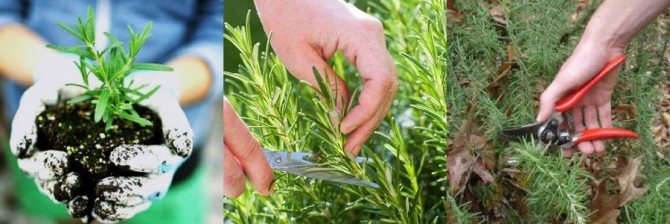

Figure 5. Growing rosemary outdoors
In the spring, it is important to apply nitrogen fertilizer to the soil, and during the growing season, a complex mineral fertilizer is applied once a month. In autumn, nitrogen fertilizers are removed, and phosphorus fertilizers are increased. So the yield of the crop is preserved and its root system is strengthened.
Preparing cuttings
Many gardeners have a common mistake in growing rosemary using cuttings. They do not withstand the seedlings for a certain amount of time for the formation of roots and plant them directly into the soil. As a result, the cuttings do not take root and die.
To avoid problems, you must adhere to the following rules:
- Prepare the pot for the plant and the soil (you can get the substrate from the store). If the soil is harvested independently, then you need to mix black soil, peat, sand and humus.
- Place small pebbles at the bottom of the container, then pour earth and moisten it.
- Make small holes and bury the seedlings 3-4 cm deep. Be sure to cut off the lower leaves and water the soil again.
- Put the container with cuttings on a warm and sunny windowsill for 1-1.5 months.
Attention! The rosemary should be watered at least four times every seven days and the pot should not be left to stagnate. It must be drained if it has gathered on a saucer.
- Remove the rosemary seedlings and transplant them to an outdoor area.
A good way to root the twigs of a plant is to place them in jars of water. It needs to be updated every 3 days. It is important to provide the twigs with light and heat.
Rosemary is very sensitive to soil type. It does not tolerate alkaline, clay and heavy soils. For the plant to feel great, it is recommended to loosen the soil, this will not allow water to linger. The shrub does not like dry weather, and excessive watering can lead to root rot.
Propagation by cuttings
By autumn, bushes grown from seeds can be propagated by cuttings. By the way, this is an effective way to preserve the plant for the next year.
Step 1. The strongest shoots are chosen and cuttings 9-10 cm long are cut from them.
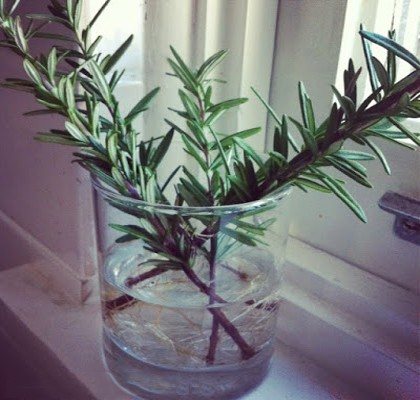

Rooting green rosemary cuttings
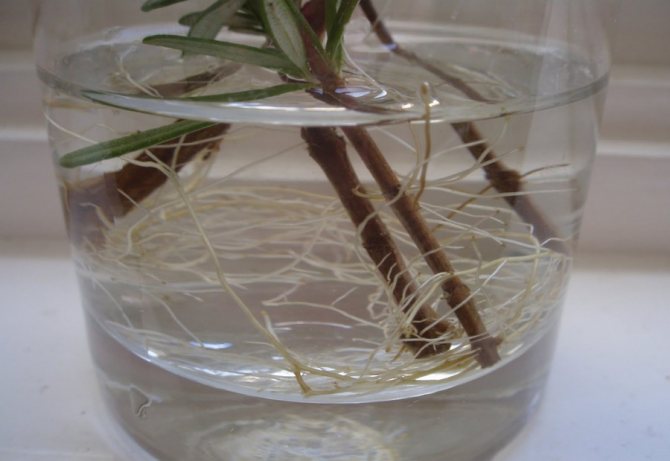

Rooted cuttings
Step 2. Prepare the soil: mix 1 part of sod land with 2 parts of sand and 1 part of peat. The resulting substrate is heated for at least an hour in the oven to destroy harmful microorganisms.
Step 3... They take a pot, pour a layer of expanded clay for drainage, then fill it with soil mixture, wate it abundantly with water.
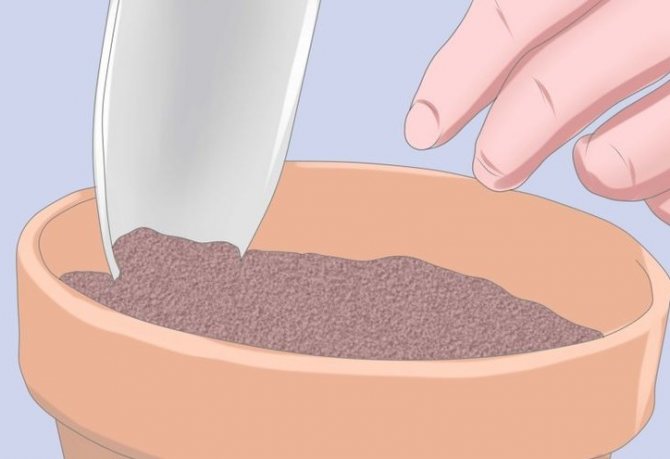

Preparing the soil
Step 4. The lower ends of the cuttings are dipped in a root or another root formation stimulator, and planted in a prepared container. The cuttings are buried in the soil by about 3-4 cm.
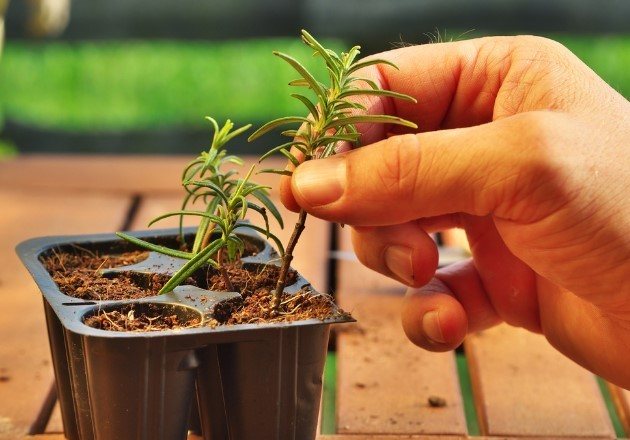

Transplanting rosemary cuttings
Step 5. Cover the pot with a transparent bag, in which holes are made for ventilation, and put it on the windowsill from the south or west side. Be sure to shade from direct sunlight.
Cover the rosemary
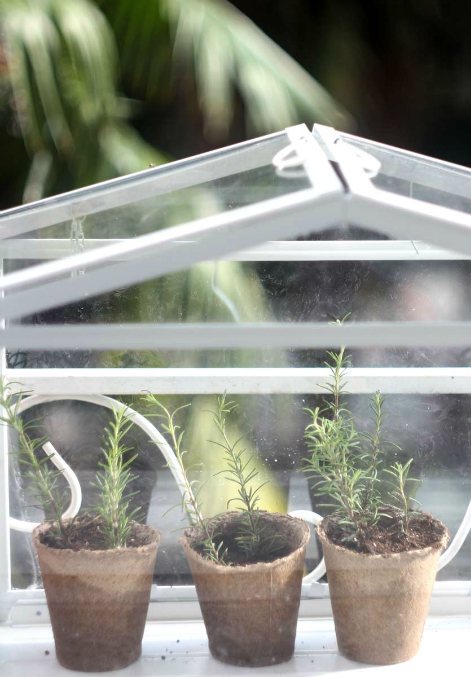

Seedlings in peat pots
It will take about three weeks for rooting. All this time, monitor the temperature in the room, do not allow sudden changes in it. Examine the cuttings carefully, immediately remove the rotten twigs. When the root system is formed, you can start transplanting the plants into separate pots. Do everything as described above, but only take more containers so that there is enough space for the roots.


Rosemary tips
Landing dates
In central Russia, it is possible to grow rosemary on a site if, when planting, the soil temperature is at around + 5-10 degrees. In the northern regions, the plant is recommended to be transplanted into greenhouses and greenhouses, because the peculiarities of the climate will not allow it to develop well. Gardeners of the central regions can start growing shrubs from the third decade of April.
Rosemary can die if grown in frosty conditions when temperatures reach -5 degrees. The shrub grows well all year round in warmth, therefore, in autumn and winter, plants must be transferred to rooms where the air must be warmed up to plus 5-15 degrees.
Choosing a landing site
Rosemary is very sensitive to external conditions, does not tolerate temperature surges and cold. The best place to grow it is in a sunny, wind-protected area. The southern and eastern sides of the vegetable gardens are the most priority for the plant.
The shrub loves light sandy, non-acidic and drained soil, because such land perfectly permeates water without holding it back at all. In addition, its looseness allows the root system to be saturated with oxygen.
In the case of a predominance of acidic soil in the area, it must be calcified. To prevent excess soil moisture, drainage should be laid at the bottom of the planting hole. Mostly it is purchased in stores or large pebbles and broken bricks are used.
Landing
To plant rosemary outdoors, you first need to root and grow the seedlings in pots or boxes. Only then are the plants transferred to the beds. In this case, it is important to maintain a distance of 1 meter between the bushes.
Before planting, a special mixture is prepared that will help the rosemary take root well in the soil. To do this, take river sand, leafy soil and peat in equal parts and 1 tbsp. l. crushed chalk per 1 kg of the resulting mixture.
Plants are dug in to the foliage leaves, watered and covered with polyethylene. It is removed no earlier than a week later. This is necessary for the rosemary to take root safely.
Very often, the stems of an adult rosemary can be exposed. In this case, it is necessary to cut off the lower shoots. The procedure is performed once every 7 years.
Shrubs can be harvested 3 years after planting during flowering. Scented twigs must be cut off along with the flowers.
Rules for the collection and procurement of raw materials
Rosemary begins to be consumed in the second year after planting. By this time, the bush will already grow strong enough and grow, and many useful substances will accumulate in its leaves and young shoots. For drying and freezing, raw materials are collected during the flowering of the bush.
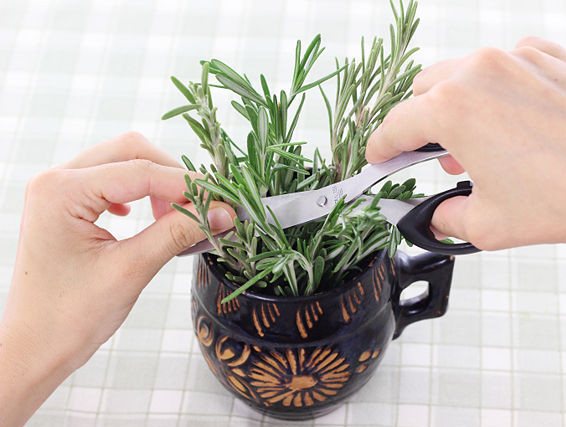

Cut off the twigs
Only young healthy stems are cut, with or without flowers.Cut shoots are laid out in a thin layer under a canopy or in a well-ventilated area with low humidity.
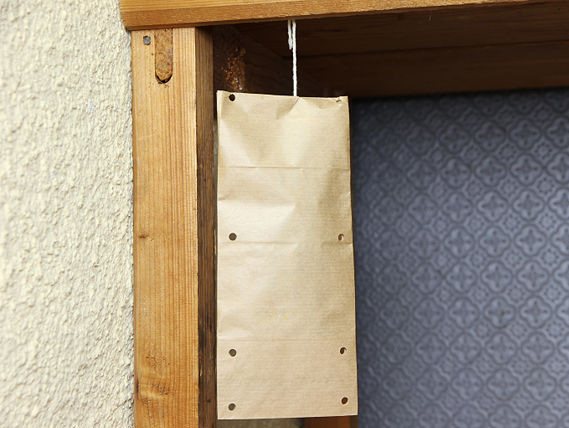

Wrap the rosemary with parchment paper while drying. Thus, dust will not settle during drying and rosemary will not fade in sunlight.
Dry rosemary separately from other aromatic herbs so as not to mix odors. When the stems are dry, they can be shredded for convenience and stored in a glass container with a tight lid.
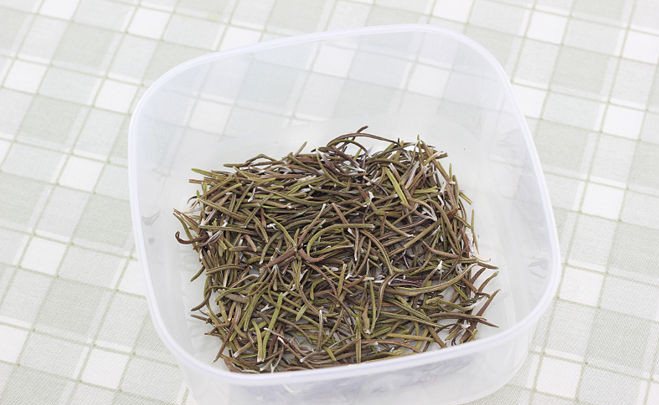

How to dry rosemary
If you prefer to freeze your herbs rather than dry them, take a clean plastic bag, fold dry, clean rosemary sprigs in them, remove excess air, and close tightly. The bags can now be placed in the freezer. With this method, greens are stored for several months without loss of taste, but in a dry form and sealed container even longer - about 2 years. But it is best, of course, to use freshly cut shoots, and growing rosemary indoors provides this opportunity.


Frozen storage
Video - Growing rosemary from seeds at home
Rosemary care
Rosemary is slow growing. For its stable development, you need to leave a sufficient number of leaves. When a bush from a twig reaches a large size and its roots fill the pot, a transplant should be made. Plants growing in containers usually grow up to 90 cm. Each time they need to be moved to larger boxes.
To prevent the rosemary from becoming too thick, it should not be pruned too often. Botanists recommend doing this in June-July, immediately after flowering.
Follow-up care
Rosemary grows slowly, so don't prune the leaves often. It is best to do this in the first months of summer, after the flowering period is over. The maximum height of a shrub in a container usually does not exceed 90 cm. Each time the shrub grows and its roots grow long, it is moved to a larger pot. After the top layer of the soil becomes dry, you need to pour warm water under the root of the flower, having previously allowed it to settle. In spring and summer, watering is carried out at intervals of 2-3 times in 7 days, in winter, less often - only 2 times a month. Spraying the plant daily in the morning or evening is helpful.
The spice does not tolerate too high or low temperatures. During the dormant period, the comfortable temperature for the flower is + 6- + 15 ° С, during the growing season it is higher than + 23- + 25 ° С. If the temperature is too high, place a cup of snow or ice next to the pot. In addition, the plant needs light. When growing at home, the best choice is to place a container of rosemary on a windowsill. For uniform development of the crown, it is unrolled every two days. In case of insufficient lighting, it is recommended to install a phytolamp, if excessive, create a shadow.
On a note!
Do not forget about air humidity. Adding moistened expanded clay to the pallet of the container with the plant will help to compensate for the dryness of the air in winter, when the apartments are heated. Additional humidification is generally not necessary in the summer months.
The plant is fed once every 30 days during the growing season, which begins in the first months of spring and ends in autumn. For this, a universal complex fertilizer is used, which is diluted with twice the amount of water. Several times a month, peat, humus or superphosphate are added to the ground, as well as fertilizers containing potassium (to enhance growth). In winter, the bush does not need feeding.

